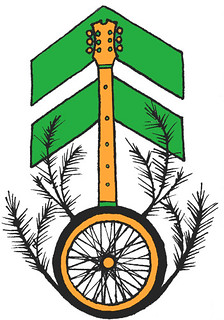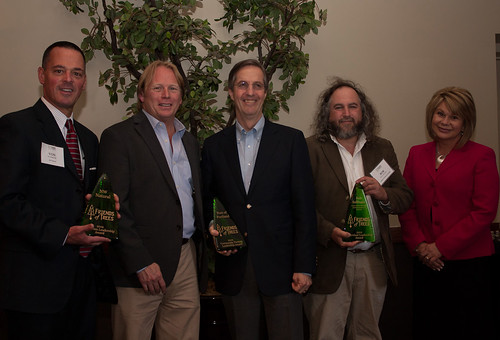Tag: Audubon
5 Questions About Backyard Habitats

So many of our Treemail readers were interested in our Backyard Certification, we wanted to offer more information about how to get certified. Fortunately, we were able to catch up with Gaylen Beatty, who founded the program in 2006 while working for Columbia Land Trust, today works closely with their partner, Audubon Society of Portland to assist the 2,700+ participants in the program. Gaylen was kind enough to go into greater detail via email about the certification process.
How long does the certification process take?
On average, it takes someone a year from the initial site visit to achieve certification. Though we support the participant for however long it takes them to achieve certification. We have many participants, who have some more difficult properties (erosion, a complex mix of invasive plants, large property) that take years to achieve certification. We have over 60% of those properties once they initially enroll that stick with the program and process to make certification.
How much does the certification process cost?
Feb 1st, we’re increasing the site visit fee to $35. That fee pays for the entire process and for the length of the time the property is within Backyard. No renewal fee for any follow up visits (certification or recertification).
What is the advantage of backyard certification?
Research is showing that even small urban lots can provide a great habitat and support biodiversity in our region. Did you know of the 500 bird species found in Oregon, 209 of those are found in the Portland-Metropolitan area for some portion of their lifecycle? Many of our participants also have some sort of food production in their garden, from vegetables to fruit trees. Providing native plants that support our native pollinators can help increase food production, even on a small lot. Having a Backyard sign in your garden, teaches neighbors, friends, etc. that you can have a beautiful garden that creates a healthy urban landscape, for people and wildlife.
How do certifications help individuals?
Our participants share stories with us almost daily on the change they’ve seen in their backyard, by making small changes in their garden to support wildlife. Here’s a quote from an email that came in earlier this week from a gold certified homeowner, “This past weekend I was in our kitchen and noticed a small creature rummaging around in the backyard in some bushes under our pine tree and Ribes. I thought at first it was just a squirrel then I noticed a bright flash of orange. I ran and got our binoculars. It was a new bird to me! I looked it up and found out it is a Varied Thrush. True it may be a common bird, but not to me. I have always maintained to more of a plant person than a bird person in my habitat work. However, the feeling of discovering a new, exciting bird in my yard gave me such a thrill. I was so proud of active “Backyard Habitat”! Just thought I’d share.”
There are over 1,000 certified homes in the Portland area, how common is it for a business to get certified?
There are 14 commercial spaces that are enrolled in Backyard Habitat. We only have four properties that are Platinum certified. Those include Green Zebra grocery store in Kenton, EMSWCD office, Apex Wellness Center and Friends Of Trees. You all fall into a small, exclusive group that showcase how an urban commercial lot can be beautiful and SO valuable for wildlife. I’d strongly encourage commercial spaces to challenge themselves to look beyond the common ornamental landscapes and become a model for what our small handful of commercial spaces have already done.
It’s Pedalpalooza time!

What better way to start the summer than by cycling with friends and neighbors along a family-friendly path that connects neighborhoods with city lakes and natural areas? This June 9 Pedalpalooza event wraps up with a community potluck picnic and live bluegrass at Columbia Park (N Lombard and N Woolsey).
The adventure begins at 2:00 pm at Pittman Addition HydroPark, N Concord and N Going, along the Concord Neighborhood Greenway in the Overlook neighborhood. The path covers just over 11 miles along Neighborhood Greenways and through natural areas at Smith and Bybee lakes. It will take about three hours, including stops along the way to learn about some of the fun projects and partnerships that make Portland’s neighborhoods unique and green. Aside from a three-block hill at the start and a gradual incline from the Columbia River, the path is flat and easy for both kids and adults.
Friends of Trees honors 2012 award winners at annual luncheon

Friends of Trees celebrated another record-breaking planting season at its annual Leadership Awards Luncheon at the Multnomah Athletic Club yesterday. At the luncheon, Friends of Trees presented its 2012 leadership awards to Bob Sallinger (Individual Leadership Award), NW Natural (Business Leadership Award), and the Port of Portland (Community Partner Leadership Award).
KGW News Anchor Tracy Barry served as emcee for the event, which was sponsored by The Oregonian and Rigert Shade Trees.
Bob Sallinger, conservation director of the Audubon Society of Portland, received the 2012 Individual Leadership Award for his successful advocacy for habitat restoration, which contributed to significant changes in Portland’s tree codes, the planting of 21,000 new street trees through Friends of Trees’ partnership with Portland’s Bureau of Environmental Services, and future restoration work through Friends of Trees’ Green Space Initiative.
Audubon Magazine features Eugene’s trees & the people who care for them

Below are excerpts from a story about Eugene, Oregon’s trees in Audubon Magazine. It includes insights from Eugene Urban Forester Mark Snyder and Friends of Trees Eugene Director Erik Burke. Read the full story here.
… What’s happening above ground is only half the battle for Eugene’s urban forestry crew. “When I was a kid I thought tree roots went down to China,” Snyder says. He explains it’s a common misconception that tree roots grow down. In fact they grow out. The best way to imagine a tree’s root system is to think of a large, Bordeaux red wine glass, he says. The large, top portion is the crown of the tree and the stem is the trunk. “Think of that wine glass sitting on a big plate or a platter,” he says. He motions his upturned hand acting as this imaginary plate. This is the tree’s root system. “It’s all shallow,” he says. “Ninety five percent of the tree root system is in the top 18 to 24 inches of soil.” …
The nature of the root system also makes choosing a location to plant critical to a tree’s survival. “Right tree, right place,” says Erik Burke, Eugene’s director for the Friends of Trees program, reciting the mantra of many a tree organization. Where a tree is planted should determine what species would be the best fit. Planting a tree in a place with less than four feet between the sidewalk and the curb, what urban arborists call the planting strip, is virtually impossible. There’s a city-approved street tree list that determines the size and species of tree that can be planted given its allotted planting strip size and soil type. …
You can read about Friends of Trees Eugene’s Arbor Day planting on April 7, 2012 and see photos below taken by Jessyca Burke at the planting.
Planting hearts
By Emma Gray
Over one hundred volunteers enjoyed the restorative beauty of sunshine at the Collins Sanctuary on Sunday, March 25, as they joined together to plant 580 new native trees and plants at the final Gift Tree Planting of the season. Sunday’s planting at the Sanctuary, a beautiful forest publicly held by Metro and managed by the Audubon Society of Portland, brought the total number of native trees and plants planted at Collins to over 2,500! We are very thankful for our partnership with Metro and Audubon that has allowed such an impact to be made on such a special place.
